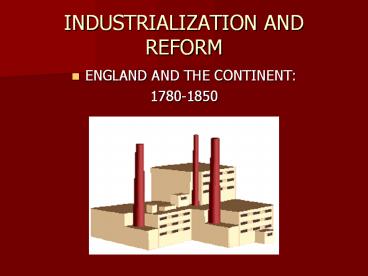INDUSTRIALIZATION AND REFORM PowerPoint PPT Presentation
1 / 21
Title: INDUSTRIALIZATION AND REFORM
1
INDUSTRIALIZATION AND REFORM
- ENGLAND AND THE CONTINENT
- 1780-1850
2
WHY ENGLAND?
- Geography and natural resources
- Economic development and efficiency
- Political support and protection
- Social conditions included population increase
- Agricultural Revolution meant greater food
production
3
INVENTIONS PUSHED INDUSTRY
- Cotton Industry 1
- Flying Shuttle Increased speed of weavers
- Water Frame Arkwrights invention produces yarn
fast - Spinning Jenny Hargreaves Jenny produced more
yarn - Mule Cromptons combined Water Frame Spinning
Jenny - Power Loom Cartwrights loom meant weavers could
keep up with spinners
Cartwrights power loom 1787
4
STEAM ENGINE PLAYS MAJOR ROLE IN INDUSTRY
- Steam Engine cause factory system to spread
beyond cotton (flour) - Started as means to pump water from coal mines
- Newcomen invents steam pump 1712
- Watt repairs a Newcomen engine and adds condenser
creating steam engine in 1760s - By 1850, 90 of English Cotton Industry steam
5
IRON INDUSTRY
- Iron transformed during I.R.
- In 1780s a better method devised to make iron
- Puddling introduced by Cort coke used to burn
away impurities - 1740 17,000 tons
- 1840 2,000,000 tons
6
RAILROAD PROMOTES TRANSPORTATION BOOM
- Started with hand carts for moving coal
- Then cast iron rails
- Then steam power in 1804
- Then Stephensons Rocket in 1830 (16 mph)
- Railroads built
7
CRYSTAL PALACE EXHIBITION
- 1851 First Industrial Worlds Fair
- Held at Londons Crystal Palace
- Made entirely of glass iron
- 6,000,000 visited 100,000 exhibits
- Displayed Englands wealth success
8
INDUSTRY SPREADS SLOWLY TO CONTINENT
- The continent experience slower and more uneven
growth than England - More agrarian than England less urban
- Lacked many of the advantages England had
- Napoleon blockade hurt trade from 1790-1815
- Customs barriers acute
- Thus I.R. delayed
9
Some Advantages For Continent
- Population growth meant both ready labor force
markets - Blockade did revive wool textile industry
- Continent borrowed ideas from England
- Governments spend
10
SOME IMPORTANT DIFFERENCESBETWEEN ENGLAND
CONTINENT
- Until 1850, the Continent lacked technical edge
- England more Laissez-Faire, less Mercantile
- Continent had more tariffs (Merc. Policy). See
Friedrich Lists, National System of Political
Econ. - Continent utilized Joint-Stock Banks less
private funds
11
3 MAJOR CENTERS
- Belgium Cotton, steam power, investment banks,
Cockerill - France lead continent in cotton manufacturing
- Germany After 1850, heavy industry exploded in
Germany
12
EASTERN EUROPE?
- Utterly lacking in industry
- Small middle class
- Rural areas dominate landscape
- Autocrats/nobles keep peasants down
- Not until late 1800s does Russia industrialize
13
REFORM IN THE INDUSTRIAL AGE
- Living conditions in urban industrialized nations
was miserable - Overcrowding, lack of sanitation, pollution,
crime, sexual immorality, drunkenness , etc.
characterized the era
14
REFORMERS EMERGE
- Disgusted by the conditions around them, some
fought for change - Chadwick sought change through modern sanitation
- Due to his efforts, England passed Public Health
Act 1848
15
NEW SOCIAL CLASSES THE INDUSTRIAL MIDDLE CLASS
- The term middle class increasing became
synonymous with commerce, industry banking - Previously term bourgeois meant merchant class
- New middle class had common values such as
resolution, initiative, ambition greed
16
NEW SOCIAL CLASSES WORKERS IN INDUSTRIAL AGE
- In the course of the 19th century, factory
workers would form an Industrial Proletariat - However, in a 1851 census from Britain,
agricultural workers still outnumbered factory
workers 2 to 1
17
UNIONS EMERGE
- Soon workers looked to labor organizations to
gain wages better conditions - Combination Acts 1799 was passed in England to
outlaw unions (repealed in 1824) - Owens formed Grand National Consolidated Trades
Union in 1834
18
CHARTISM
- Another movement was called Chartism
- 1838- In England this movement demanded greater
democracy, 8-hour days, male suffrage, payments
for Parliament - Lasting effect was worker consciousness
19
LUDDITES SMASH MACHINES
- Some reacted negatively to the new
industrialization - The Luddites, skilled craftsmen in England,
attacked the machines of the new era - While some view them as naïve, others see them as
illustrative of intense feelings against the new
industrialization
20
GOVERNMENT RESPONDS
- Slowly, governments passed a variety of acts
aimed at alleviating urban hardships - A series of Factory Acts were passed in the early
19th century - These acts limited working hours and child labor
- Other acts included the Ten Hours Act and the
Coal Mines Act
21
EMERGENCE OF AN ORDERED SOCIETY
- During the upheavals of the late 18th and early
19th centuries, the ruling elite became more
concerned about social order - Their response was to create increase police
presence and numbers, and to institute prison
reform including less capital punishment a
greater focus on rehabilitation

